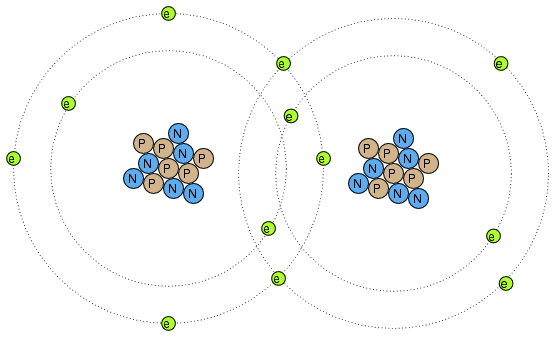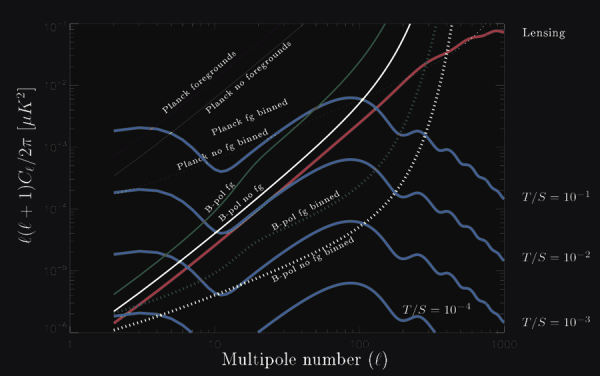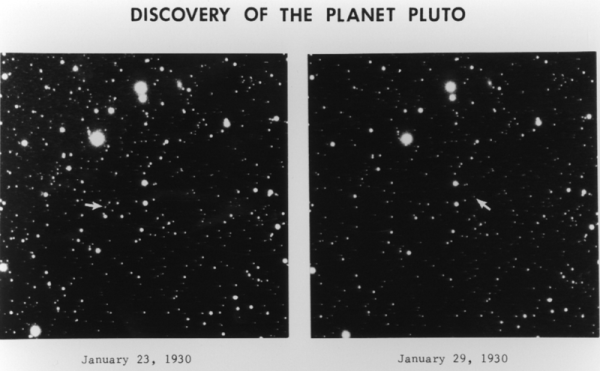“In that little party there was not one who would desert another; yet we were of different countries, different colours, different races, different religions--and one of us was of a different world.” -Edgar Rice Burroughs
It's the end of yet another week, and so it's time to look back on all we've written about and all you've discussed. There's been a lot, too! This past week has seen the telling of some terrific tales at Starts With A Bang, including:
- What happens to matter as the Universe expands? (for Ask Ethan),
- Top 5 Great Christmas Sweaters (for our Weekend Diversion),
- The Ultimate Trip (for our final Messier Monday),
- The Moment of Truth for BICEP2,
- Why Pluto Still Matters, and
- The Story of Mars (for Throwback Thursday).
Some topics appear always to be controversial for some reason (like Pluto), even though the science is quite clear. Let’s see what you had to say, and dive in to your Comments of the Week!
Image credit: Ned Wright’s cosmology tutorial, via http://www.astro.ucla.edu/~wright/nocenter.html.
From Bogdan on matter in the expanding Universe: "So you’ve explained what happens to individual particles, but what about collections of atoms? If space is expanding does that also mean that matter becomes less dense over time? Are we all slowly spreading apart?"
We had good responses to this from Sinisa, Michael, wow and eric, and I particularly liked Michael's note that "This question gets asked by at least one person in every single posting by Ethan on the cosmological expansion." Yup.
But it's such an intuitive question that I can't really fault anyone for asking it! Rather than think about expansion, however, which is a long-term effect that results, I want you to think about the cause of the expansion, which is a combination of two things: the initial conditions that the Universe was born with, and the presence of dark energy, or energy intrinsic to space itself. Now let's consider a set of atoms that are bound together.
 Image credit: the most boring molecule in the Universe, via http://www.allaboutcircuits.com/vol_1/chpt_11/1.html.
Image credit: the most boring molecule in the Universe, via http://www.allaboutcircuits.com/vol_1/chpt_11/1.html.
Will they be affected by the initial conditions of the Universe? Not at all, no more than a baseball thrown at 100 mph -- once you catch it -- would be affected by its initial conditions once you let it go. Once you've overcome the initial expansion from a global scale, it makes no difference on a local one.
So what of the second part: what of the dark energy? That's always there, and it's an energy (and a repulsive force) intrinsic to space itself. But so long as there's an attractive force that's great enough to counteract it -- and even a tiny gravitational or electromagnetic force is enough to do so -- there won't be any expansion that occurs as a result.
So in summation, once you overcome the initial expansion of the Universe, and once there's any attractive force that's strong enough to beat the mind-bogglingly weak push of dark energy, you're bound, and you always will be!
 Image credit: © 2014 Yellowbulldog, via http://www.yellowbulldog.co.uk/products/street-fighter-xmas-jumper.
Image credit: © 2014 Yellowbulldog, via http://www.yellowbulldog.co.uk/products/street-fighter-xmas-jumper.
From Pete A on our Christmas sweater choice: "Wonderful article: it makes me fully appreciate how fortunate I am to live in a tiny country that still values independent thinking."
I thought this was tongue-in-cheek, but then I checked Pete A's email and realized it was from the UK, where they make some of these Christmas sweaters, including the one above. Still, you might appreciate this one from an even tinier (by population) country: Canada.
 Image credit: via http://www.christmassweaters.ca/feature-xmas-sweaters/duck-hunt-christm….
Image credit: via http://www.christmassweaters.ca/feature-xmas-sweaters/duck-hunt-christm….
Do you like the little Santa behind the duck hunt tree? Please, my Canadian friends, wear the orange vest even if you're dressed as Santa when you're doing your duck hunting!
From JP on the end of our Messier Monday: "I just came across your website. I would have loved to have known about your Messier Project and followed all of it. What a great idea that was! Will you have another somewhat similar observing project in the near future?"
JP, our archives go all the way back to 2008, and if you want to pick up the Messier Mondays anywhere you go, they have the date of publication on them, so you know that will be a good time to observe that particular object year in and year out. That's one of the wonderful things about the Messier catalogue: these objects don't fade on human-lifetime timescales!
Image credit: Caltech & CTCP © All rights Reserved, viahttp://preposterousuniverse.com/MCTCP/astro.php.
From Sinisa Lazarek on BICEP2, Planck and the CMB: "I might be wrong, but from what I read earlier this year, Planck’s sensitivity in detecting b-modes is much weaker then bicep2, polar bear and other dedicated detectors, meaning… I’m not sure that their results on b-mode will refute anything. BICEP2 results are wrong because of planks dust maps and foreground polarizations that are available since summer, that weren’t available when bicep published the results."
So there are two things I want to point you towards, because this is kind of correct but also a slight misinterpretation of what's relevant. Planck had two choices they could have made as far as what type of mission they could have run: an extended mission or the "nominal" mission. They went with the nominal mission, meaning -- once they figured out their foregrounds correctly -- could have seen B-modes down to sensitivities of tensor-to-scalar ratios (r) of about 0.07 or greater.
 Image credit: © Copyright 2007 B-Pol Team, via http://www.b-pol.org/bpol-science.php.
Image credit: © Copyright 2007 B-Pol Team, via http://www.b-pol.org/bpol-science.php.
This is huge, because BICEP2 was claiming values of r ~ 0.2, which Planck should definitively be able to refute once the polarization data is in! In fact, the 2013 data release of Planck disfavored any r that wasn't less than 0.11, so there already was a tension (albeit a weak one) between Planck and BICEP2. This new release won't detect gravitational waves down to super low scales, but this is the best tool we have for measuring B-mode polarization on large angular scales: say 5 degrees and up!
In other words: go, Planck, go!
From Ron on Pluto: "The images are *very* interesting & informative, but this article seems a pointless and immature wish by an adult (who should be *glad* he’s grown up and earning a living instead of living under Mommy & Daddy’s thumb) for a childhood fantasy."
I... don't think this was about Pluto at all. Instead, I would encourage everyone to realize that when you comment on the internet, it lives on forever. I don't know what sort of issues with either parents or children you have, or what article you think you read, or who you think I might be, but as gently as possible, I'd like to encourage you to rethink how you use the internet in the future.
From MandoZink on the asteroid belt: "I was a bit surprised when I saw the asteroid animation. It shows them following a somewhat triangular-shaped orbit with contrived vertices at Lagrangian points L3, L4 and L5. Is this true? If so, do the Trojans or the Lagrangian points themselves affect the asteroid orbits between Jupiter and Mars, or is it just the Trojans? Are there not also objects (like those shown as green on the animation) orbiting at L3, or do they only exist at L4 and L5?"
Let's show this again:
 Image credit: Petr Scheirich, 2005, of http://sajri.astronomy.cz/asteroidgroups/groups.htm.
Image credit: Petr Scheirich, 2005, of http://sajri.astronomy.cz/asteroidgroups/groups.htm.
The asteroids you're talking about are a class known as Hildas (rather than "Greeks" and "Trojans" which are concentrated ahead of and behind Jupiter), and they orbit between Mars and Jupiter. The triangular pattern you see is actually an optical trick; what's really happening is that these are elliptical orbits around the Sun, where the aphelion of these objects coincides with L3 (opposite Jupiter), or L4 or L5 (where the Greeks and Trojans live). See for yourself, as we follow one of each in the animation below!
 Image credit: Petr Scheirich, 2005, of http://sajri.astronomy.cz/asteroidgroups/groups.htm.
Image credit: Petr Scheirich, 2005, of http://sajri.astronomy.cz/asteroidgroups/groups.htm.
There is no stable group at L3, since L3 -- like the L2 Lagrange Point -- is an unstable equilibrium; bodies can only be kept there with continual maneuvering, something that asteroids don't spontaneously do on their own.
Do also be aware that the asteroids you're most familiar with are likely the Cybeles, which orbit in between Mars and Jupiter in a roughly circular plane; these are not includes on the original diagram, but you can see a nice animation of them here.
Image credit: Dave Jarvis, via http://www.wwu.edu/skywise/a101_planets.html.
From Frilla Poo on Pluto as well: "Now I’ve got one word for you – Jupiter. There’s a real planet! Big, lots of color, and it can take on a comet with no complaint. A little gassy maybe, but it makes up for it in sheer size. And it gots moons it can truly be proud of – active moons, not teeny-tiny frozen ones.
Pluto is a little moron. Sheesh! Because of this Plutogate mess, astronomers now might be unjustly suspicious of several other planets. And for what? You Pluto lovers can be real proud of yourselves. I hope you’re happy."
And as a counterpoint to Ron's comment, I have to say: this was awesome. Also take note that if we take Frilla's definition, "real" planets have X-rays for aurorae!
For those of you who just need to have the "is Pluto a planet" conversation, because you can't simply accept and appreciate it for the wondrous object it is, read this. Even Alan Stern couldn't hate it!
And finally from Bruce Dickinson (not the Iron Maiden guy or the music producer) on the story of Mars: "Phil, Not often I disagree with your comments but on the comment that “water once flowed freely across the Martian surface” is not one that is supported by the surface geochemistry of Mars. Basically, the chemistry of Mars indicates weathering has been isochemical."
Phil? Me? What?
As puzzling as it is to be called Phil, I'm even more surprised at the rest of your comment. I've got to express my puzzlement at your statement that the surface geochemistry of Mars doesn't support the statement that water once flowed freely across the Martian surface, because... I mean, we have the images that show things that can really only be dried up riverbeds. We know how rivers evolve on Earth, what flowing patterns they leave, how water builds sedimentary rock and so on... and that's what we see on Mars!
And you don't even have to take my word for it. From Alfred McEwan, geologist and leader of the HiRise mission:
These ridges are thought to be old river channels, but wind erosion has created inverted topography. What was low (the channel bottoms) was more resistant to erosion, so now it is relatively high.
Or how about this image,
 Image credit: NASA / Mars Global Surveyor, via http://www.giss.nasa.gov/research/briefs/gornitz_03/.
Image credit: NASA / Mars Global Surveyor, via http://www.giss.nasa.gov/research/briefs/gornitz_03/.
and NASA's statement on this feature, Nanedi Vallis:
Flat terraces along the canyon walls (top) and tight oxbow meanders (lower left) are evidence that repeated episodes of flowing water have carved this winding channel. Collapse of weathered rocky debris into the lower canyon has further widened this chasm.
All of which is to say, I don't doubt that there are unsolved problems about Mars' surface geochemistry, but to assert that there wasn't a past where liquid water freely flowed seems an absurdity to me. But perhaps there are pieces of evidence you can present to the contrary? After all, science isn't about dogmas and preconceptions; if you can present better evidence and superior science to explain what we're seeing, that's an opportunity for us all to learn something new!
Thanks for a great week, and I'll see you back here for more as December continues!





